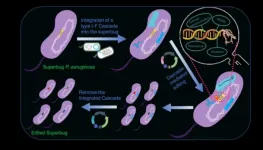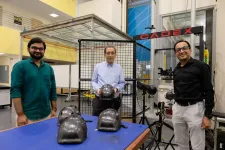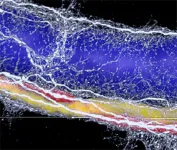(Press-News.org) TROY, N.Y. -- An innovative testing platform that more closely mimics what cancer encounters in the body may allow for more precise, personalized therapies by enabling the rapid study of multiple therapeutic combinations against tumor cells. The platform, which uses a three-dimensional environment to more closely mirror a tumor microenvironment, is demonstrated in research published in Communications Biology.
"This whole platform really gives us a way to optimize personalized immunotherapy on a rapid, high throughput scale," said Jonathan Dordick, Institute Professor of chemical and biological engineering and member of the Center for Biotechnology and Interdisciplinary Studies (CBIS) at Rensselaer Polytechnic Institute, who led this research. "You can imagine somebody having cancer, and you quickly biopsy the tumor and then you use this biochip platform to identify very quickly -- within a day or two -- what specific treatment modality might be ideally suited against a particular cancer."
Of particular interest to researchers is the behavior of a specific type of immune cell known as natural killer (NK) cells, which seek out cancer or viruses within the body, bind to their receptors, and excrete an enzyme meant to kill the unwanted cells. The platform studied in this paper allows researchers to compare what happens when the NK cells are left to fight tumor cells on their own versus how they behave when an antibody or cancer drug, or a combination of the two, is added.
The platform is a small two-piece plastic chip that's about the size of a microscope slide. One side of the sandwich chip contains 330 tiny pillars upon which researchers can place an external matrix, made of a gel-like substance, which mimics the mechanical environment of a tumor cell. When cancer cells are placed inside this gel-like structure, they're encouraged to grow into a spheroid shape, much as they would inside the body. The second piece contains 330 microwells within which NK cells can be added in suspension -- much as they would flow, untethered inside the body.
At Rensselaer, Dordick collaborated with Seok-Joon Kwon, senior research scientist in CBIS, and Sneha Gopal, who recently received her Ph.D. based, in part, on this study. The Rensselaer team collaborated with researchers from Konyang University and Medical & Bio Decision Company Ltd. To test this platform, researchers studied two types of breast cancer cells, as well as pancreatic cancer cells, with various combinations of NK cells, two monoclonal antibodies, and an anti-cancer chemotherapy drug.
"You can screen very quickly to determine what combinations of NK cells, antibodies, and chemotherapeutic drugs target the cancer cells within the spheroid geometry," Dordick said. "What really is amazing is we see very significant differences between what happens in that spheroid, within the slots of the chip, versus what would happen in a more traditional two-dimensional cell culture that's often used in the screening."
In the spheroid design, for instance, the chemotherapy drug paclitaxel had little effect on the three types of cancer cells on its own, whereas in a traditional two-dimensional system, Dordick said, the drug may appear to do well. It performed dramatically better when it was combined with both NK cells and an antibody.
"This platform moves researchers closer to personalized medicine," said Deepak Vashishth, director of CBIS. "This work conducted by Professor Dordick and his research group is an excellent example of how we, at Rensselaer, are providing a new angle to human health by developing new approaches at the intersection of engineering and life sciences to enhance cures for diseases such as cancer."
To further the potential use of this tool, Dordick said that it must be tested on a wide range of cancer types, including a tumor microenvironment that consists of multiple different types of cells. In the future, he envisions that the platform has the potential to identify combination therapies that work best against a patient's specific cancer, enabling the identification and delivery of personalized immunotherapy.
INFORMATION:
About Rensselaer Polytechnic Institute
Founded in 1824, Rensselaer Polytechnic Institute is America's first technological research university. Rensselaer encompasses five schools, 32 research centers, more than 145 academic programs, and a dynamic community made up of more than 7,600 students and over 100,000 living alumni. Rensselaer faculty and alumni include more than 145 National Academy members, six members of the National Inventors Hall of Fame, six National Medal of Technology winners, five National Medal of Science winners, and a Nobel Prize winner in Physics. With nearly 200 years of experience advancing scientific and technological knowledge, Rensselaer remains focused on addressing global challenges with a spirit of ingenuity and collaboration. To learn more, please visit http://www.rpi.edu.
It's a favourite first-order for the day, but while a quick coffee may perk us up, new research from the University of South Australia shows that too much could be dragging us down, especially when it comes to brain health.
In the largest study of its kind, researchers have found that high coffee consumption is associated with smaller total brain volumes and an increased risk of dementia.
Conducted at UniSA's Australian Centre for Precision Health at SAHMRI and a team of international researchers*, the study assessed the effects of coffee on the brain among 17,702 UK Biobank participants (aged 37-73), finding that those who drank more than six cups of coffee a day had a 53 per cent increased risk of dementia.
Lead researcher and UniSA PhD candidate, ...
Silicon, a semi-metal, bonds in its natural form with four other elements and its three-dimensional structure takes the form of a tetrahedron. For a long time, it seemed impossible to achieve the synthesis and characterisation of a two-dimensional equivalent - geometrically speaking, a square. Now scientists from the field of Inorganic Chemistry at Heidelberg University have succeeded in producing a crystalline complex with such a configuration. PD Dr Lutz Greb from the Institute of Inorganic Chemistry underlines that it has surprising physical and chemical properties and, in the field of molecular chemistry, will open up new approaches to using the second most abundant element in the Earth's crust for catalysis and materials research.
As a classical ...
The touchscreen technology used in billions of smartphones and tablets could also be used as a powerful sensor, without the need for any modifications.
Researchers from the University of Cambridge have demonstrated how a typical touchscreen could be used to identify common ionic contaminants in soil or drinking water by dropping liquid samples on the screen, the first time this has been achieved. The sensitivity of the touchscreen sensor is comparable to typical lab-based equipment, which would make it useful in low-resource settings.
The researchers say their proof of concept could one day be expanded for a wide range of sensing applications, including for biosensing or medical diagnostics, right from the phone in your pocket. The results are reported ...
Many applications, from fiber-optic telecommunications to biomedical imaging processes require substances that emit light in the near-infrared range (NIR). A research team in Switzerland has now developed the first chromium complex that emits light in the coveted, longer wavelength NIR-II range. In the journal Angewandte Chemie, the team has introduced the underlying concept: a drastic change in the electronic structure of the chromium caused by the specially tailored ligands that envelop it.
Many materials that emit NIR light are based on expensive or rare metal complexes. Cheaper alternatives that emit in the NIR-I range between 700 and 950 nm have been developed but NIR-II-emitting complexes of non-precious metals remain extremely rare. Luminescence in the NIR-II range (1000 to 1700 ...
A research team led by Wim Annaert (VIB-KU Leuven) uncovered the early assembly of gamma-secretase, a protein complex linked to numerous cellular processes including the development of Alzheimer's disease. In a first step, two dimeric subcomplexes are formed, which independently exit the ER and only afterwards assemble into a four-subunit complex. This 'buckle up' mechanism is thought to prevent premature assembly and activity. The new insights are very relevant, as gamma-secretase is an important potential therapeutic target for Alzheimer's and other ...
A research team led by Dr Aixin YAN, Associate Professor from the Research Division for Molecular & Cell Biology, Faculty of Science, in collaboration with Honorary Clinical Professor Patrick CY WOO from the Department of Microbiology, Li Ka Shing Faculty of Medicine, the University of Hong Kong (HKU), reported the development of a transferrable and integrative type I CRISPR-based platform that can efficiently edit the diverse clinical isolates of Pseudomonas aeruginosa, a superbug capable of infecting various tissues and organs and a major source of nosocomial infections. The ...
As cities worldwide expand their networks of cycling paths and more cyclists take to the streets, the chances of cycling accidents and potential collisions increase as well, underscoring the need for proper cycling safety in dense urban areas.
According to a World Health Organisation report in 2020, more than 60 per cent of the reported bicycle-related deaths and long-term disabilities are a result of accidents with head injuries.
Researchers from Nanyang Technological University, Singapore (NTU Singapore), in collaboration with French specialty materials leader Arkema, have developed a tougher, safer bicycle helmet using a combination of materials. The new helmet prototype has higher energy absorption, reducing the amount of energy ...
With the application of a novel three-dimensional imaging technology, researchers at Karolinska Institutet in Sweden have discovered that one portion of the autonomic nervous system in the liver undergoes severe degeneration in non-alcoholic fatty liver disease. The study, which is conducted in mice and human liver tissue, shows that the degeneration of nerves is correlated with the severity of liver pathology. The results are being published in the journal Science Advances.
Non-alcoholic fatty liver disease is the most common hepatic disorder, with prevalence around 25 percent globally. Approximately ...
The building sector in the U.S. accounts for 39 percent of energy use, with commercial buildings responsible for about half of that. As cities grapple with climate change, making commercial buildings more efficient is a key part of the solution.
Researchers at the University of Pittsburgh Swanson School of Engineering and the Mascaro Center for Sustainable Innovation used the City of Pittsburgh to create a model built upon the design, materials and purpose of commercial buildings to estimate their energy usage and emissions. While other models may ...
FRANKFURT/HANNOVER. The international team of geoscientists led by Prof. Silke Voigt from the Goethe University Frankfurt, Prof. Ireneusz Walaszczyk from the University of Warsaw and Dr André Bornemann from LBEG have thoroughly investigated 40 metres of the geological strata sequence in the former limestone quarry at Hasselberg. The researchers determined that this is only sequence in the transition between Turonian and Coniacian without gaps and it therefore represents a perfect rock sequence to serve geoscientists from all over the world as a reference for their research - a "Global Stratotype Section and Point (GSSP)" or, in the jargon of geosciences, a "golden nail".
Certain group of bivalve mollusks of the family Inoceramidae, first appeared in the Coniacian, and ...




